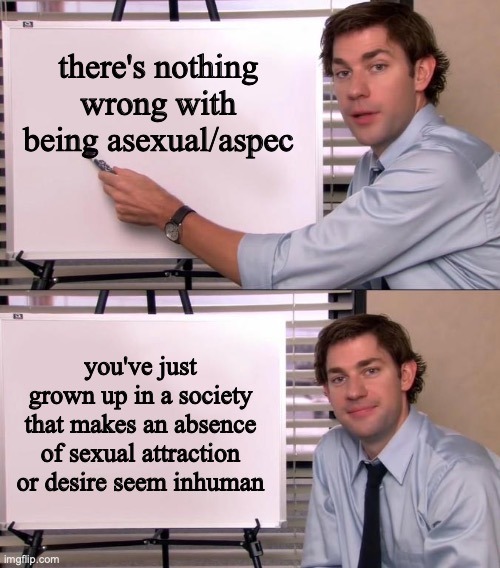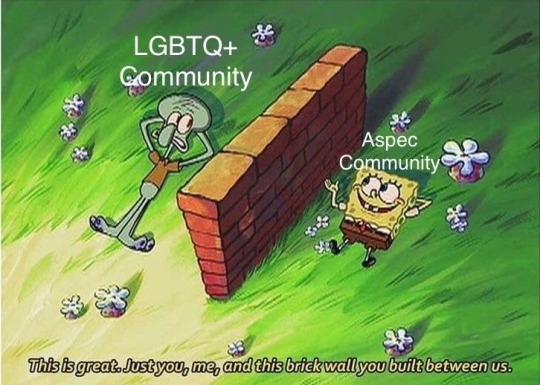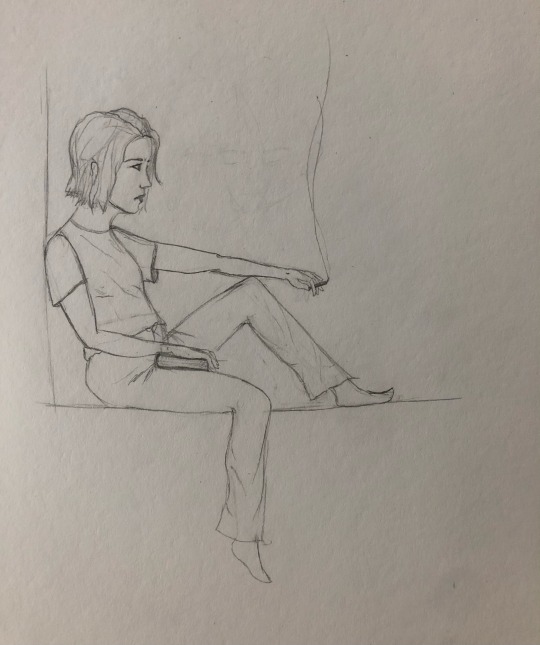Text
a little late for trans awareness week but beautiful every day of the year.
766 notes
·
View notes
Text
I’m always gonna be pissed that amatonormatvity as a term and a model for understanding society was literally mocked into disuse by exclusionists because of its association with aromantic folks.
Amatonormativity, honestly, has approximately fuck-all to do with aros. We did not even coin it, we’re simply the only people who actually take it seriously cause we’re among the ones who are most hurt by it. And it PISSES me the fuck off that it is not a widespread model used in greater queer discussions.
37K notes
·
View notes
Text
*ahem*
Yelena Belova Is Aromantic & Asexual
"b-but"
No, shut up
This post brought to you by The Asexual Yelena Gang ™
223 notes
·
View notes
Text
“Those poor boys”

“She deserves to be punished too.”

“I’m not saying I support rape, but-”

“Sorry to say - she deserved it.”

“She put herself in harm’s way”

“But if she was fingered, then that’s not rape.”

“She ruined their lives.”

1M notes
·
View notes
Text
How I feel discussing my sexuality with other aroaces:
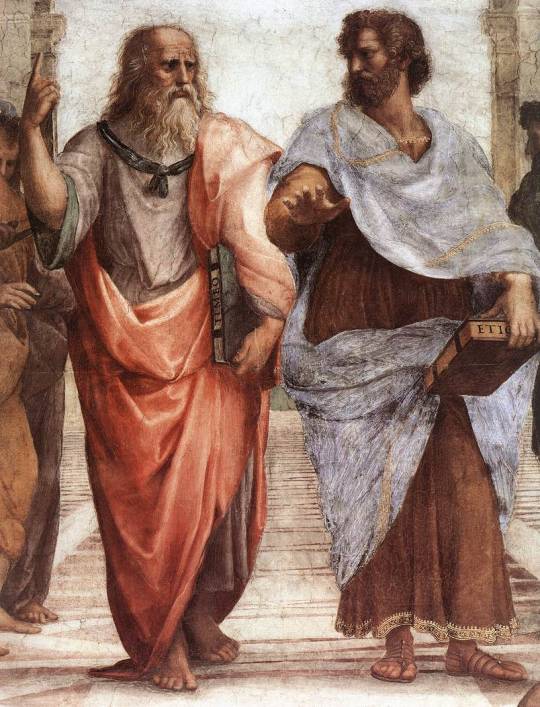
Explaining it to my friends:

Explaining it to people outside the LGBT+ community:
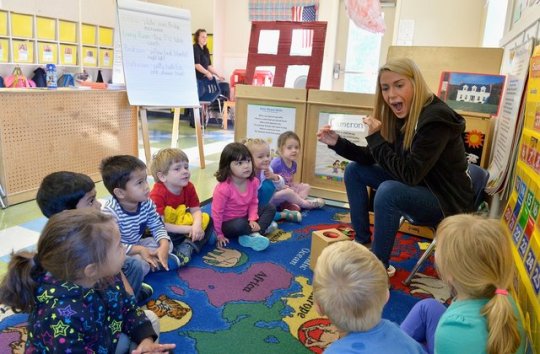
8K notes
·
View notes
Text

15 notes
·
View notes
Text

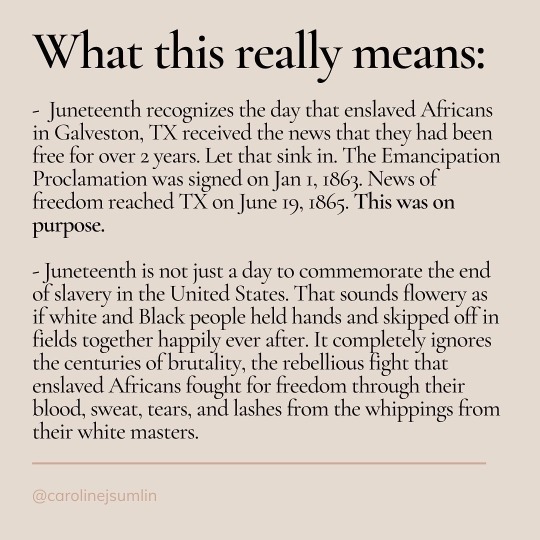

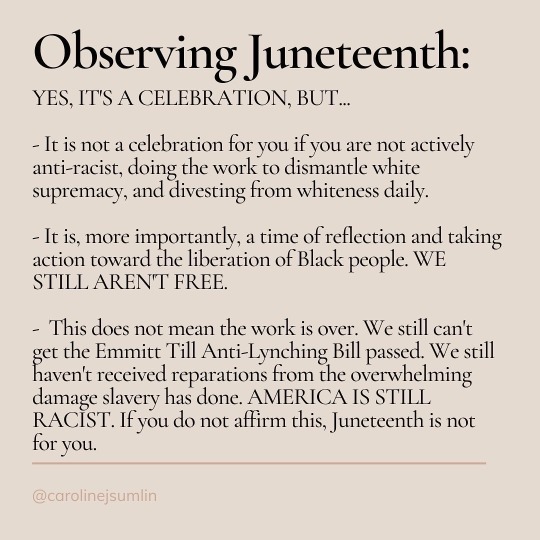
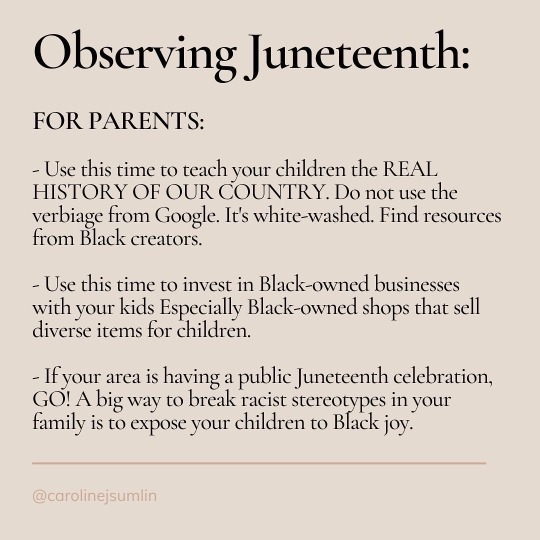


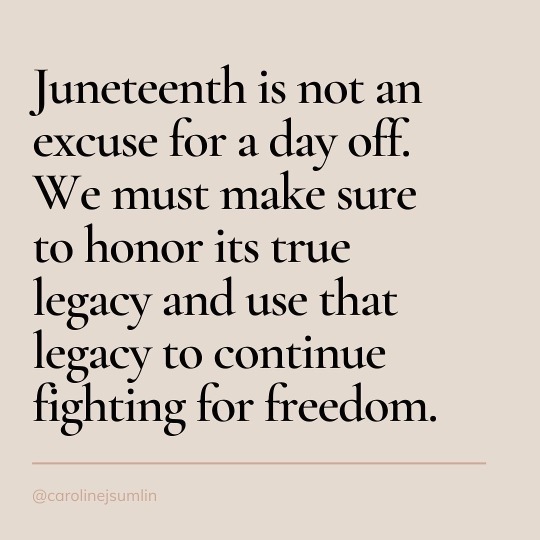
Happy Juneteenth! Here’s some info about Juneteenth becoming a national holiday & what that means for us.
15K notes
·
View notes
Text
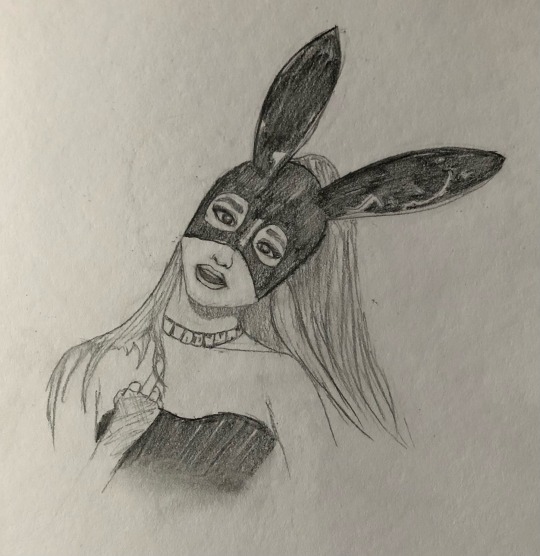
4 notes
·
View notes
Text
Story Structures for your Next WIP
hello, hello. this post will be mostly for my notes. this is something I need in to be reminded of for my business, but it can also be very useful and beneficial for you guys as well.
everything in life has structure and storytelling is no different, so let’s dive right in :)
First off let’s just review what a story structure is :
a story is the backbone of the story, the skeleton if you will. It hold the entire story together.
the structure in which you choose your story will effectively determine how you create drama and depending on the structure you choose it should help you align your story and sequence it with the conflict, climax, and resolution.
1. Freytag's Pyramid
this first story structure i will be talking about was named after 19th century German novelist and playwright.
it is a five point structure that is based off classical Greek tragedies such as Sophocles, Aeschylus and Euripedes.
Freytag's Pyramid structure consists of:
Introduction: the status quo has been established and an inciting incident occurs.
Rise or rising action: the protagonist will search and try to achieve their goal, heightening the stakes,
Climax: the protagonist can no longer go back, the point of no return if you will.
Return or fall: after the climax of the story, tension builds and the story inevitably heads towards...
Catastrophe: the main character has reached their lowest point and their greatest fears have come into fruition.
this structure is used less and less nowadays in modern storytelling mainly due to readers lack of appetite for tragic narratives.
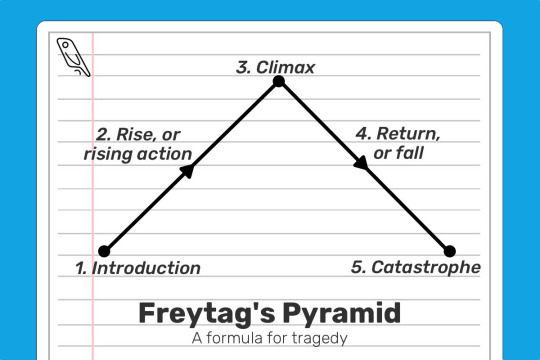
2. The Hero's Journey
the hero's journey is a very well known and popular form of storytelling.
it is very popular in modern stories such as Star Wars, and movies in the MCU.
although the hero's journey was inspired by Joseph Campbell's concept, a Disney executive Christopher Vogler has created a simplified version:
The Ordinary World: The hero's everyday routine and life is established.
The Call of Adventure: the inciting incident.
Refusal of the Call: the hero / protagonist is hesitant or reluctant to take on the challenges.
Meeting the Mentor: the hero meets someone who will help them and prepare them for the dangers ahead.
Crossing the First Threshold: first steps out of the comfort zone are taken.
Tests, Allie, Enemies: new challenges occur, and maybe new friends or enemies.
Approach to the Inmost Cave: hero approaches goal.
The Ordeal: the hero faces their biggest challenge.
Reward (Seizing the Sword): the hero manages to get ahold of what they were after.
The Road Back: they realize that their goal was not the final hurdle, but may have actually caused a bigger problem than before.
Resurrection: a final challenge, testing them on everything they've learned.
Return with the Elixir: after succeeding they return to their old life.
the hero's journey can be applied to any genre of fiction.

3. Three Act Structure:
this structure splits the story into the 'beginning, middle and end' but with in-depth components for each act.
Act 1: Setup:
exposition: the status quo or the ordinary life is established.
inciting incident: an event sets the whole story into motion.
plot point one: the main character decided to take on the challenge head on and she crosses the threshold and the story is now progressing forward.
Act 2: Confrontation:
rising action: the stakes are clearer and the hero has started to become familiar with the new world and begins to encounter enemies, allies and tests.
midpoint: an event that derails the protagonists mission.
plot point two: the hero is tested and fails, and begins to doubt themselves.
Act 3: Resolution:
pre-climax: the hero must chose between acting or failing.
climax: they fights against the antagonist or danger one last time, but will they succeed?
Denouement: loose ends are tied up and the reader discovers the consequences of the climax, and return to ordinary life.
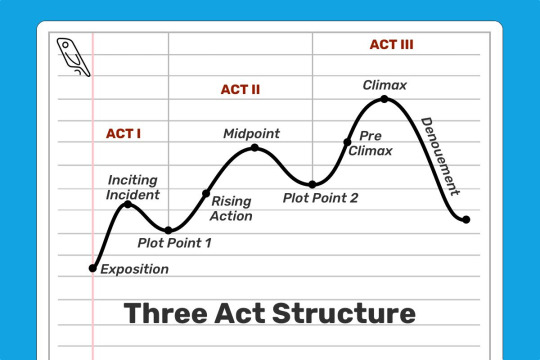
4. Dan Harmon's Story Circle
it surprised me to know the creator of Rick and Morty had their own variation of Campbell's hero's journey.
the benefit of Harmon's approach is that is focuses on the main character's arc.
it makes sense that he has such a successful structure, after all the show has multiple seasons, five or six seasons? i don't know not a fan of the show.
the character is in their comfort zone: also known as the status quo or ordinary life.
they want something: this is a longing and it can be brought forth by an inciting incident.
the character enters and unfamiliar situation: they must take action and do something new to pursue what they want.
adapt to it: of course there are challenges, there is struggle and begin to succeed.
they get what they want: often a false victory.
a heavy price is paid: a realization of what they wanted isn't what they needed.
back to the good old ways: they return to their familiar situation yet with a new truth.
having changed: was it for the better or worse?
i might actually make a operate post going more in depth about dan harmon's story circle.
5. Fichtean Curve:
the fichtean curve places the main character in a series of obstacles in order to achieve their goal.
this structure encourages writers to write a story packed with tension and mini-crises to keep the reader engaged.
The Rising Action
the story must start with an inciting indecent.
then a series of crisis arise.
there are often four crises.
2. The Climax:
3. Falling Action
this type of story telling structure goes very well with flash-back structured story as well as in theatre.
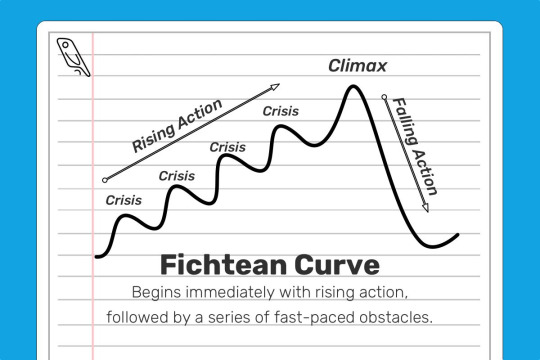
6. Save the Cat Beat Sheet:
this is another variation of a three act structure created by screenwriter Blake Snyder, and is praised widely by champion storytellers.
Structure for Save the Cat is as follows: (the numbers in the brackets are for the number of pages required, assuming you're writing a 110 page screenplay)
Opening Image [1]: The first shot of the film. If you’re starting a novel, this would be an opening paragraph or scene that sucks readers into the world of your story.
Set-up [1-10]. Establishing the ‘ordinary world’ of your protagonist. What does he want? What is he missing out on?
Theme Stated [5]. During the setup, hint at what your story is really about — the truth that your protagonist will discover by the end.
Catalyst [12]. The inciting incident!
Debate [12-25]. The hero refuses the call to adventure. He tries to avoid the conflict before they are forced into action.
Break into Two [25]. The protagonist makes an active choice and the journey begins in earnest.
B Story [30]. A subplot kicks in. Often romantic in nature, the protagonist’s subplot should serve to highlight the theme.
The Promise of the Premise [30-55]. Often called the ‘fun and games’ stage, this is usually a highly entertaining section where the writer delivers the goods. If you promised an exciting detective story, we’d see the detective in action. If you promised a goofy story of people falling in love, let’s go on some charmingly awkward dates.
Midpoint [55]. A plot twist occurs that ups the stakes and makes the hero’s goal harder to achieve — or makes them focus on a new, more important goal.
Bad Guys Close In [55-75]. The tension ratchets up. The hero’s obstacles become greater, his plan falls apart, and he is on the back foot.
All is Lost [75]. The hero hits rock bottom. He loses everything he’s gained so far, and things are looking bleak. The hero is overpowered by the villain; a mentor dies; our lovebirds have an argument and break up.
Dark Night of the Soul [75-85-ish]. Having just lost everything, the hero shambles around the city in a minor-key musical montage before discovering some “new information” that reveals exactly what he needs to do if he wants to take another crack at success. (This new information is often delivered through the B-Story)
Break into Three [85]. Armed with this new information, our protagonist decides to try once more!
Finale [85-110]. The hero confronts the antagonist or whatever the source of the primary conflict is. The truth that eluded him at the start of the story (established in step three and accentuated by the B Story) is now clear, allowing him to resolve their story.
Final Image [110]. A final moment or scene that crystallizes how the character has changed. It’s a reflection, in some way, of the opening image.
(all information regarding the save the cat beat sheet was copy and pasted directly from reedsy!)
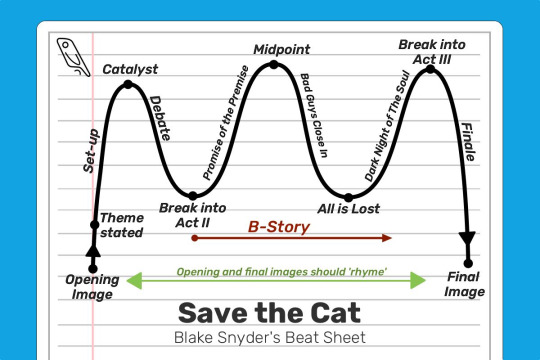
7. Seven Point Story Structure:
this structure encourages writers to start with the at the end, with the resolution, and work their way back to the starting point.
this structure is about dramatic changes from beginning to end
The Hook. Draw readers in by explaining the protagonist’s current situation. Their state of being at the beginning of the novel should be in direct contrast to what it will be at the end of the novel.
Plot Point 1. Whether it’s a person, an idea, an inciting incident, or something else — there should be a "Call to Adventure" of sorts that sets the narrative and character development in motion.
Pinch Point 1. Things can’t be all sunshine and roses for your protagonist. Something should go wrong here that applies pressure to the main character, forcing them to step up and solve the problem.
Midpoint. A “Turning Point” wherein the main character changes from a passive force to an active force in the story. Whatever the narrative’s main conflict is, the protagonist decides to start meeting it head-on.
Pinch Point 2. The second pinch point involves another blow to the protagonist — things go even more awry than they did during the first pinch point. This might involve the passing of a mentor, the failure of a plan, the reveal of a traitor, etc.
Plot Point 2. After the calamity of Pinch Point 2, the protagonist learns that they’ve actually had the key to solving the conflict the whole time.
Resolution. The story’s primary conflict is resolved — and the character goes through the final bit of development necessary to transform them from who they were at the start of the novel.
(all information regarding the seven point story structure was copy and pasted directly from reedsy!)

i decided to fit all of them in one post instead of making it a two part post.
i hope you all enjoy this post and feel free to comment or reblog which structure you use the most, or if you have your own you prefer to use! please share with me!
if you find this useful feel free to reblog on instagram and tag me at perpetualstories
Follow my tumblr and instagram for more writing and grammar tips and more!
13K notes
·
View notes
Text
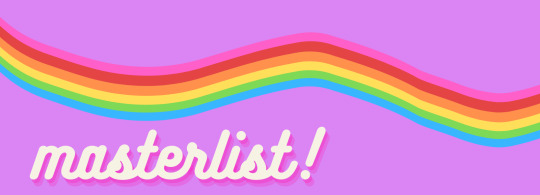
Hello and welcome to Pridewrite 2021! We’re very excited to bring this to you this year, so here’s a mobile friendly list of all our important links. (If you’re on computer, the links might not be underlined, but they’re still there don’t worry!)
Info / How to Join In
•Rules
•Tagging Guideline
•FAQ
Prompts - (links tba as the challenge progresses!)
•Prompt List
•Day One / Alt
•Day Two / Alt
•Day Three / Alt
•Day Four / Alt
•Day Five / Alt
•Day Six / Alt
•Day Eight / Alt
•Day Nine / Alt
•Day Ten / Alt
•Day Eleven / Alt
•Day Twelve / Alt
•Day Thirteen / Alt
•Day Fourteen / Alt
•Day Fifteen / Alt
•Day Sixteen / Alt
•Day Seventeen / Alt
•Day Eighteen / Alt
•Day Nineteen / Alt
•Day Twenty / Alt
•Day Twenty One / Alt
•Day Twenty Two / Alt
•Day Twenty Three / Alt
•Day Twenty Four / Alt
•Day Twenty Five / Alt
•Day Twenty Six / Alt
•Day Twenty Seven / Alt
•Day Twenty Eight / Alt
•Day Twenty Nine / Alt
•Day Thirty / Alt
129 notes
·
View notes
Text
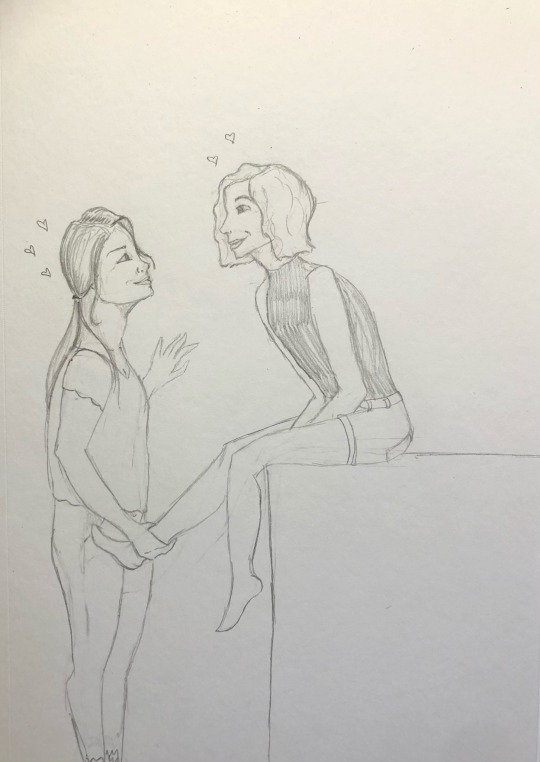
Lady Love 💕
2 notes
·
View notes
Text
😍😍
everything we know about the heartstopper netflix show so far
updated april 26
previous version of this post: x
i’ll be continuously updating this post as we go, so if you see this post circling around, going back to the source post should give you the latest info :)
characters:
the cast consists of our heartstopper gang, plus two new characters (imogen and isaac), with two exceptions:
oliver was scrapped from the story because he doesn’t contribute much to the story, heartstopper already has a very large cast, and the logistical issues of working with an actor that age
aled isn’t in the show is because of his role in radio silence: “To include Aled in the Heartstopper show and give him a satisfying storyline would almost certainly involve having to change and/or ignore major elements of the story of RADIO SILENCE, which is not what I or any of you want, I hope!”
aled’s role in the story will somewhat be taken over by isaac, but he is a different character entirely:
“Isaac is the fourth member of Charlie, Tao and Elle’s friendship group. He’s a bookworm, and doesn’t say much, but when he does, it’s usually very insightful and/or funny (…)”
“Imogen is a totally new character. She’s a good friend of Nick’s. She has a very bold, determined personality (…)”
mr. farouk, david and sahar won’t appear in season one, but they might in a potential future season.
casting & production:
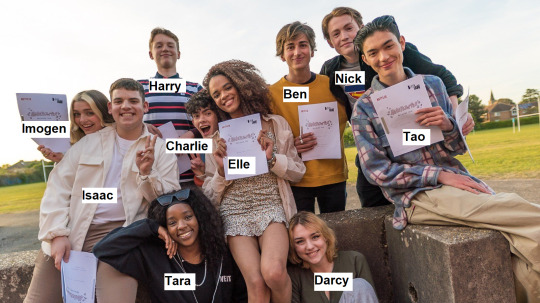
nick will be played by kit connor, charlie will be played by by joe locke
imogen will be played by rhea norwood, isaac by tobie donovan, harry by cormac hyde-corrin, tara by corinna brown, elle by yasmin finney, ben by sebastian croft, darcy by kizzy edgell, and tao by william gao (tori is in the show, she simply hasn’t been announced yet!)
filming is currently in process!
the first season will have eight episodes. there might be more seasons, but that entirely depends on if netflix/whoever is in charge allows it
alice herself has written all episodes, with input from the director and producers
the release date is tba, currently expected to be in the first half of 2022
other stuff:
you’ll be able to watch it wherever netflix is available!
when casting was announced the website broke twice lol
3K notes
·
View notes
Text
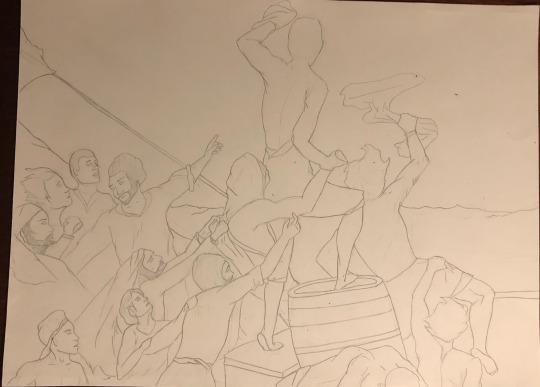
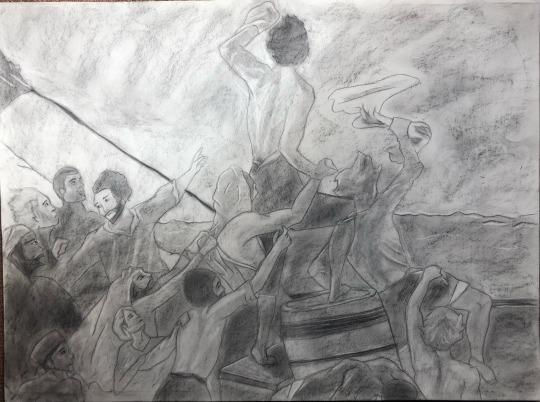
The Raft of the Medusa copy 🚣
0 notes
